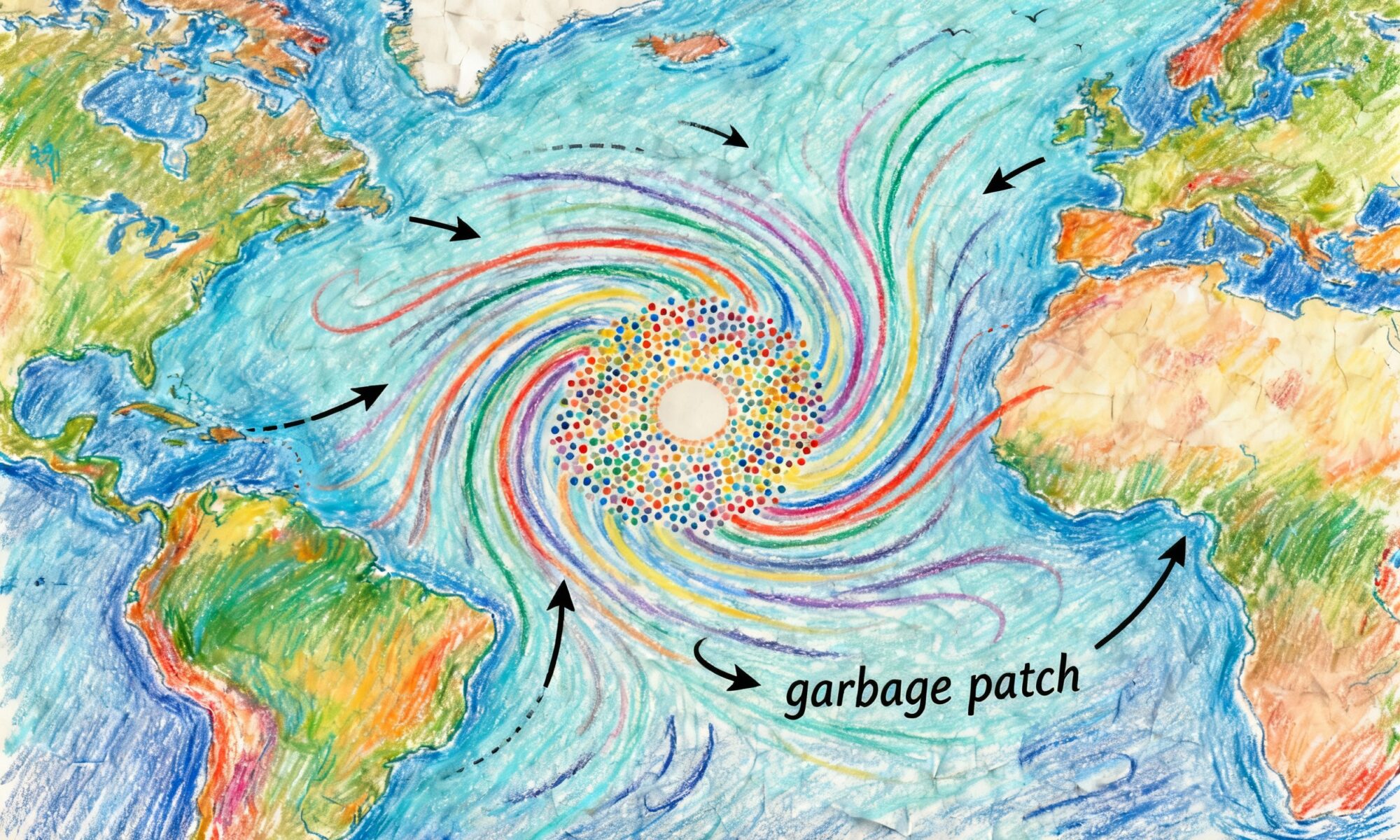The Ocean’s Ancient Highways
Long before plastic existed, the world’s oceans were governed by massive, slow-moving systems of circular currents known as gyres. Formed by global wind patterns and the Earth’s rotation, these five major gyres act like colossal, oceanic conveyor belts. The North Pacific Subtropical Gyre, the system responsible for the garbage patch, has been spinning for millennia. Its clockwise rotation, driven by the California, North Equatorial, Kuroshio, and North Pacific currents, created a stable, calm area at its center—an oceanic doldrum.
For centuries, this system was largely invisible to human history, a matter for mariners and, perhaps, the frigatebirds that ride its winds. Anything that floated into the gyre—pumice from volcanic eruptions, logs from distant shores—would eventually be drawn toward this quiet center and trapped. The stage was set, the mechanism was in place; all that was missing was a material durable enough to survive the journey and accumulate on a truly historic scale.
The Birth of a Throwaway World
That material arrived in the mid-20th century. While early plastics like Bakelite had existed since the early 1900s, it was World War II that supercharged the industry. Materials like nylon, PVC, and polyethylene were critical to the war effort, used for everything from parachutes and aircraft components to electrical insulation. American and European manufacturing capacity for these new “wonder materials” exploded.
When the war ended, chemical companies like Dow and DuPont faced a pivotal choice: scale back production or find a new market. They chose the latter, embarking on one of the most successful marketing campaigns in history. They sold the American public on a vision of a new, effortless future. The key selling point? Convenience through disposability.
Historical production data tells a stark story of this exponential rise:
- 1950: Global plastic production stood at roughly 2 million metric tons.
- 1970: Production had surged to approximately 30 million metric tons.
- 2020: The world produced over 367 million metric tons of plastic.
A 1955 article in LIFE magazine, infamously titled “Throwaway Living”, celebrated the liberation of the housewife from the drudgery of washing dishes. A featured photograph showed a family joyously flinging disposable plates, cups, and cutlery into the air, with the caption estimating the items would take “40 hours to clean—except that no housewife need bother.” This wasn’t just a new product; it was a new philosophy. For the first time in human history, an entire culture was being built around items designed to be used once and discarded without a second thought.
A Collision of Worlds: When Plastic Met the Gyre
The unintended consequence of this revolution began almost immediately. A plastic bag blown from a landfill in California, a bottle washed down a river in Japan, or fishing gear lost from a trawler in the mid-Pacific would all begin the same slow journey. Carried by coastal currents, this debris eventually reached the powerful conveyor belts of the North Pacific Gyre.
The existence of this vast accumulation remained largely unknown until 1997. While returning to California from a transpacific sailing race, oceanographer and captain Charles Moore diverted his course and sailed through the heart of the gyre. He was stunned. For seven straight days, he saw an endless stream of plastic debris. As he later wrote, “It seemed unbelievable, but I never found a clear spot. In the week it took to cross the subtropical high, no matter what time of day I looked, plastic debris was floating everywhere.”
Moore’s discovery revealed the terrible truth. Unlike organic material, plastics don’t truly biodegrade. Instead, exposed to sunlight and wave action, they photodegrade. A plastic bottle doesn’t rot away; it breaks down into progressively smaller and smaller fragments, a process that can take centuries. The Great Pacific Garbage Patch, therefore, is not a solid island of trash you can walk on. It is more accurately described as a thick, particle-filled “smog” or soup, composed of trillions of microplastic pieces suspended below the surface, interspersed with larger, more recognizable items.
An Archaeological Dig in the Ocean
Today, studying the garbage patch is a form of modern archaeology. By analyzing the debris, scientists can trace its origins and, in doing so, tell the history of our consumption. A 2018 study published in Scientific Reports analyzed the composition of the patch’s mass and delivered a surprising finding: over 75% of the large plastic mass originated from fishing activities at sea, with fishing nets alone accounting for 46%.
This data points not just to consumer waste but to industrial practices and the global history of commercial fishing. Other items found floating in the gyre serve as time capsules: a Japanese plastic crate from the 1970s, a North American Game Boy from the 1990s, a Styrofoam cup that looks almost new despite being decades old. Each piece is an artifact, a tangible record of our economic activities, product designs, and cultural habits, preserved in the slow, swirling current of the Pacific.
The Great Pacific Garbage Patch is a sobering historical legacy. It is the physical result of post-war optimism, industrial ingenuity, and a cultural shift toward convenience, all meeting the indifferent, timeless power of the ocean. It is an unintended continent of our own making, a floating archive of the Anthropocene, reminding us that in history, nothing is ever truly thrown “away.”
